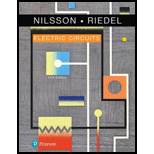
a.
Find the roots of the characteristic equation that describes the voltage response of the circuit.
a.
Answer to Problem 1P
The roots of the characteristic equation are
Explanation of Solution
Given data:
The values of resistance, inductance, and capacitance of a parallel RLC circuit are given as follows:
Formula used:
Write the expression for roots of characteristic equation for a parallel RLC circuit as follows:
Here,
Write the expression for Neper frequency as follows:
Here,
Write the expression for resonant radian frequency as follows:
Here,
Calculation:
Substitute
Substitute 12.5 H for
Substitute
The roots are determined as follows:
Conclusion:
Thus, the roots of the characteristic equation are
b.
Find whether the response is over-, under-, or critically damped response.
b.
Answer to Problem 1P
The response for the given system is an over-damped response.
Explanation of Solution
Given data:
The value of capacitance is adjusted to give a neper frequency of
Formula used:
Write the expression for over-damped response for a parallel RLC circuit as follows:
Write the expression for under-damped response for a parallel RLC circuit as follows:
Write the expression for critically damped response for a parallel RLC circuit as follows:
Calculation:
From Part (a), the values of
Substitute
The expression is satisfied. Therefore, the response is the over-damped response. As the Equation (4) is satisfied, it is not required to check the Equations (5) and (6).
Conclusion:
Thus, the response for the given system is an over-damped response.
c.
Calculate the value of resistance that yields a damped frequency of
c.
Answer to Problem 1P
The value of resistance that yields a damped frequency of
Explanation of Solution
Given data:
Formula used:
Write the expression for damped frequency for a parallel RLC circuit as follows:
Calculation:
Rearrange the expression in Equation (7) as follows:
Substitute
Rearrange the expression in Equation (2) as follows:
Substitute
Conclusion:
Thus, the value of resistance that yields a damped frequency of
d.
Find the roots of the characteristic equation for the value of resistance obtained in Part (c).
d.
Answer to Problem 1P
The roots of the characteristic equation are
Explanation of Solution
Calculation:
From Part (c), the value of resistance is obtained as
Substitute
Substitute
The roots are determined as follows:
Conclusion:
Thus, the roots of the characteristic equation are
e.
Calculate the value of resistance
e.
Answer to Problem 1P
The value of resistance that makes the voltage response critically damped is
Explanation of Solution
Calculation:
From Equations (2) and (3), substitute
Rearrange the expression for resistance of the capacitor.
Substitute 12.5 H for
Conclusion:
Thus, the value of resistance that makes the voltage response critically damped is
Want to see more full solutions like this?
Chapter 8 Solutions
Electric Circuits. (11th Edition)
Additional Engineering Textbook Solutions
Concepts Of Programming Languages
Starting Out with C++ from Control Structures to Objects (9th Edition)
Java: An Introduction to Problem Solving and Programming (8th Edition)
Mechanics of Materials (10th Edition)
Elementary Surveying: An Introduction To Geomatics (15th Edition)
Computer Science: An Overview (13th Edition) (What's New in Computer Science)
- Solve this problem and show all of the workarrow_forwardSolve this problem and show all of the workarrow_forwardA 3 km long multimode step index fibre operating at a bandwidth of 4 Mhz has a core refractive index of 1.48 and a refractive index difference of 1 %. Evaluate the rms pulse broadening per kilometer which results from chromatic dispersion.arrow_forward
- Find the Thevenin Equivalent of the circuit below, show all steps;arrow_forwardFind the Thevenin Equivalent Circuit of the following and find the current through R_L, show all steps;arrow_forwardFind the Thevenin Equivalent Circuit of the circuit below and the current through R_L , show all steps;arrow_forward
- Find the Norton Equivalent of the below and the voltage across R_L, show all steps;arrow_forwardUse Mesh Analysis to find the current through the laod resistor R_L. Show all steps;arrow_forwardFind Thevenin Equivalent of the circuit below and the current through the load resistor R_L. Show all steps;arrow_forward
- If = 5000 A actual time IDMT ---R,, Reand R3 The Tsm relays R, and R3 Draw The characteistic relays time margin between Tsm = 0.5 RCT=500/1 CS-125% TSM = 2 TSM = 0.2 and -0.6 R2 CTS = 500/1 Cs=100% Tsm=0.4 R3 CTS = 400/1 Cs=125% TSM = 2arrow_forwardLet X and Y be random variables having joint density function 01.5). (c) p(x) and p(y).arrow_forwardThe joint density function of two continuous random variables X and Y is: p(x, y) = {cxy 0 < x < 4,1 < y < 5 0 otherwise Find (i) the constant c (ii)P(1arrow_forwardarrow_back_iosSEE MORE QUESTIONSarrow_forward_ios
 Introductory Circuit Analysis (13th Edition)Electrical EngineeringISBN:9780133923605Author:Robert L. BoylestadPublisher:PEARSON
Introductory Circuit Analysis (13th Edition)Electrical EngineeringISBN:9780133923605Author:Robert L. BoylestadPublisher:PEARSON Delmar's Standard Textbook Of ElectricityElectrical EngineeringISBN:9781337900348Author:Stephen L. HermanPublisher:Cengage Learning
Delmar's Standard Textbook Of ElectricityElectrical EngineeringISBN:9781337900348Author:Stephen L. HermanPublisher:Cengage Learning Programmable Logic ControllersElectrical EngineeringISBN:9780073373843Author:Frank D. PetruzellaPublisher:McGraw-Hill Education
Programmable Logic ControllersElectrical EngineeringISBN:9780073373843Author:Frank D. PetruzellaPublisher:McGraw-Hill Education Fundamentals of Electric CircuitsElectrical EngineeringISBN:9780078028229Author:Charles K Alexander, Matthew SadikuPublisher:McGraw-Hill Education
Fundamentals of Electric CircuitsElectrical EngineeringISBN:9780078028229Author:Charles K Alexander, Matthew SadikuPublisher:McGraw-Hill Education Electric Circuits. (11th Edition)Electrical EngineeringISBN:9780134746968Author:James W. Nilsson, Susan RiedelPublisher:PEARSON
Electric Circuits. (11th Edition)Electrical EngineeringISBN:9780134746968Author:James W. Nilsson, Susan RiedelPublisher:PEARSON Engineering ElectromagneticsElectrical EngineeringISBN:9780078028151Author:Hayt, William H. (william Hart), Jr, BUCK, John A.Publisher:Mcgraw-hill Education,
Engineering ElectromagneticsElectrical EngineeringISBN:9780078028151Author:Hayt, William H. (william Hart), Jr, BUCK, John A.Publisher:Mcgraw-hill Education,





